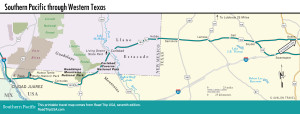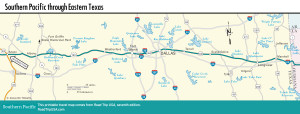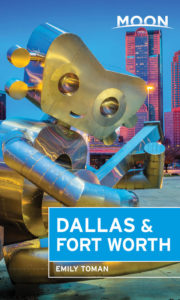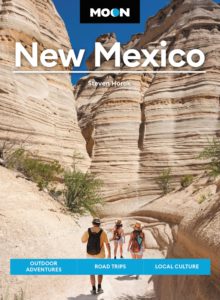Dallas and Fort Worth
US-180 Across Fort Worth and Dallas
From Weatherford and the west, it’s easiest to approach Fort Worth and Dallas via I-20 and I-30, which separate west of the city. From I-30, old US-80 enters Fort Worth on Camp Bowie Boulevard, running right past the museums of the Cultural District to the heart of downtown. East of Fort Worth, the older roads disappear under the modern freeways, so hop onto I-30 and beeline past Arlington, where the stadia for the Texas Rangers and Dallas Cowboys stand around the Six Flags over Texas amusement park before reaching Dallas.
The old road between Fort Worth and Dallas, now signed as Hwy-180, approaches downtown Dallas on Commerce Street, passing the notorious Texas School Book Depository before heading down Main Street. Southwest of downtown, a great stretch of roadside Americana has been reborn as the Bishop Arts District, a lively mix of art galleries, boutiques, and restaurants like the wonderful Lockhart Smokehouse BBQ (400 W. Davis St., 214/944-5521). East of Dallas, the old main road passes through Deep Ellum neighborhood before leaving town past the historic Cotton Bowl football stadium, on the grounds of the Texas State Fair (held here in late September or early October).
Dallas and Fort Worth
Like warring branches of an extended family, Dallas and Fort Worth are inseparable arch-rivals. Both towns lay fair claim to being capitals of their respective industries. Fort Worth (pop. 932,116) calls itself “Cowtown” but has a surprisingly sophisticated range of cultural centers and feels like an altogether more “Texan” place; it was founded during the heyday of the Chisholm Trail and still retains much of its Wild West past. Meanwhile, Dallas (pop. 1,382,267) boomed after the discovery of oil in east Texas during the 1930s and has remained a fossil fuels powerhouse, becoming famous around the world for the Dallas Cowboys football team, its luxury department store Neiman Marcus, and the eponymous 1980s TV soap opera.
In terms of things to see and do, Fort Worth may hold the winning hand. The wonderful Kimbell Art Museum (3333 Camp Bowie Blvd., 817/332-8451, Tues.-Sun., permanent collection free, special collections $18) is one of the most perfectly beautiful modern buildings on the planet, designed as a series of vaulted galleries by Louis Kahn. This small museum, which includes a Renzo Piano-designed pavilion, stands at the heart of the Fort Worth Cultural District, which also includes the Tadao Ando-designed Modern Art Museum of Fort Worth (3200 Darnell St., 817/738-9215, Tues.-Sun., $16) and, across the street, the Amon Carter Museum (3501 Camp Bowie Blvd., 817/738-1933, Tues.-Sun., free), displaying the country’s finest collection of Wild West and other American art.
Head 2 mi (3.2 km) north of downtown Fort Worth, head to the Stockyards (817/624-4741), on Main and Exchange Streets. For a taste of how Texas used to be, spend some time wandering these two short blocks of turn-of-the-20th-century buildings, stretching west from the still-busy Fort Worth Stockyards and housing some of the city’s most popular places to eat, drink, and be merry. After dark, check out Billy Bob’s Texas (817/624-7117, $2 and up), the “World’s Largest Honky-Tonk,” which has live music almost every night, often featuring famous names such as Willie Nelson.
Farther out on the north side of Fort Worth is the U.S. government’s Bureau of Engraving and Printing (9000 Blue Mound Rd., 817/231-4000 or 866/865-1194, Tue.-Fri.), where you can watch billions of dollars being made as you walk along an enclosed walkway suspended over the production floor. Be sure to factor in time needed to get through security for this tour.
In Dallas, sightseers head to The Sixth Floor Museum at Dealey Plaza (411 Elm St., 214/747-6660, daily, $18) in the former Texas School Book Depository, on the west side of downtown. Besides the gruesome novelty value of looking out from the same place where Lee Harvey Oswald shot (or didn’t shoot . . .) President John F. Kennedy on November 22, 1963, this extensive museum describes the historical context and discusses the myriad conspiracy theories. Amidst the forest of skyscrapers downtown is the pedestrian-friendly Dallas Arts District, where you’ll find the Dallas Museum of Art (1717 N. Harwood St., 214/922-1200, Tues.-Sun., free) and the elegant Nasher Sculpture Center (2001 Flora St., 214/242-5100, Tues.-Sun., $10). At the west end, the Perot Museum of Nature and Science (2201 N. Field St., daily, 214/428-5555) has four floors of entertaining and natural history exhibits.
Between Dallas and Fort Worth, the Texas Rangers (817/972-RANGERS—817/972-7264) play at retro-modern Globe Life Park, off I-30 at the Ballpark Way exit in Arlington. Games are broadcast on 103.3 ESPN.
Where to Eat and Stay in Dallas and Fort Worth
Linked (or is it divided?) by a trio of fast freeways (I-20, I-30, and Hwy-183), Dallas and Fort Worth lie some 30 miles or so apart across the plains of northeast Texas. Each city is circled by its own ring road. Two north-south freeways (I-35W through Fort Worth and I-35E through downtown Dallas) complete the high-speed network.
Food in Fort Worth, not surprisingly, tends to the beefy. Cattlemen’s Steak House (2458 N. Main St., 817/624-3945), in the historic Stockyards, has steaks of all cuts and sizes, plus barbecue and some seafood. Joe T. Garcia’s (2201 N. Commerce St., 817/626-4356, cash only) may or may not be the world’s biggest Tex-Mex restaurant. Its outdoor patio and roving mariachi bands have kept it popular for decades. Another Fort Worth institution, the 1950s landmark Paris Coffee Shop (704 W. Magnolia, 817/335-2041, Mon.-Sat.) has big breakfasts, chicken-fried steak, and delicious fresh fruit pies.
In Dallas, east of the I-35E Central Expressway from downtown, Deep Ellum is a post-industrial district rapidly gentrifying with an influx of boutiques, restaurants, and nightclubs. Vestiges of its scruffier still past remain: biker bars like Reno’s Chop Shop Saloon (210 N. Crowdus St., 214/744-1200), a block north of Elm Street. North of downtown, upscale Uptown has a popular hiking-biking rail-trail and the Katy Trail Ice House (3127 Routh St., 214/468-0600), a relaxing outdoor beer garden, perfect for eating burgers and drinking a few cold ones after a long day on the trail. The historic four-star Adolphus Hotel (1321 Commerce St., 214/742-8200, $300) in downtown, built in 1912 by beer magnate Adolphus Busch, is a stylish place to stay.
In Fort Worth, the Embassy Suites (600 Commerce St., 817/332-6900, $180 and up) is centrally located near Sundance Square. Bonnie and Clyde (both of whom grew up and are buried in Dallas, in different cemeteries) stayed in the Stockyards Hotel (109 E. Exchange Ave., 817/625-6427, $220 and up), a turn-of-the-20th-century hotel that has been restored and redecorated according to various themes, including the Depression-era bank robbers. The downstairs bar is fun too: It has saddles instead of bar stools.
Maps of the Southern Pacific Route through Texas

















